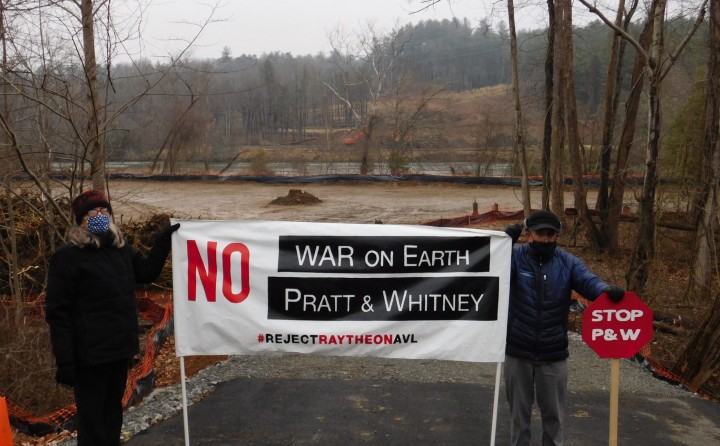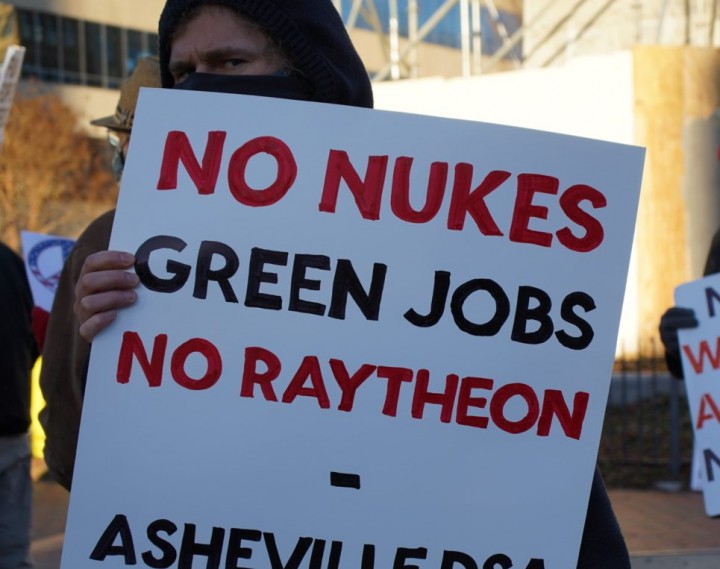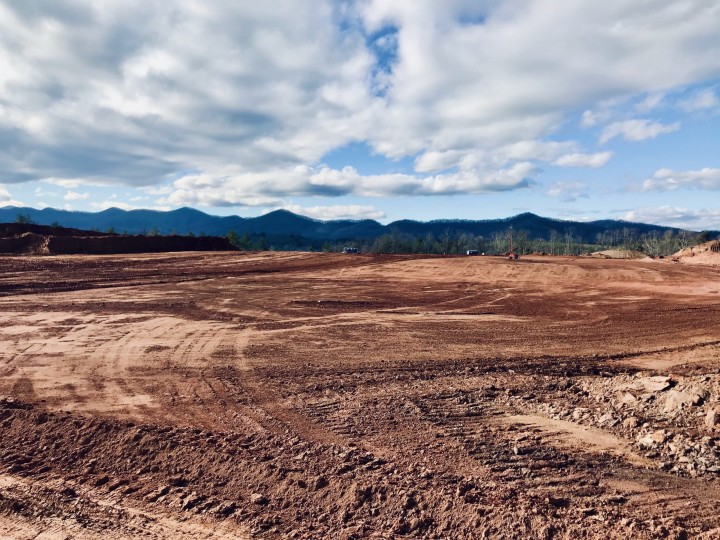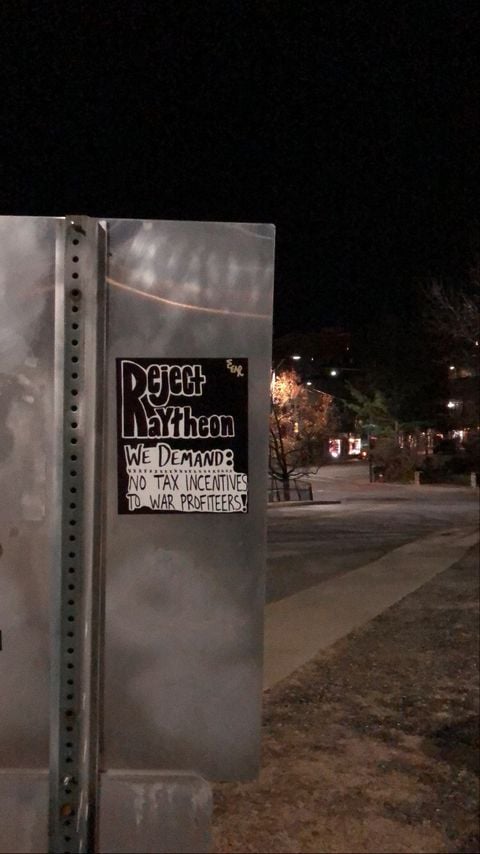What is Pratt & Whitney building?
The jet engines company will build a 1.2 million square foot state-of-the-art factory to manufacture airfoil turbines for both civil and military aircraft. They claim that 25-30% of their engines are bound for military planes, incl., the F-35. The manufacturing plant will sit on 100 acres of a 445 acre tract currently owned by developer Biltmore Farms, LLC. The land is bordered by French Board River, the Blue Ridge Parkway, and Interstate 26 just on the other side of the river from Rt. 191 and the NC Arboretum. A 5-lane bridge will be built across the French Broad River from the intersection of Rt. 191 and the entrance to the Blue Ridge Parkway to create easy access to the factory. A road will go from the bridge up the hill to a hilltop factory site. Currently there is no paved access to the site. Also to be constructed on the site are 1,200 parking spaces, a Duke energy substation near the bridge, and a AB Tech training facility. AB Tech is partnering with Pratt & Whitney to prepare machine operators for the plant.
Pratt & Whitney claims it will eventually employ 800 skilled ad professional workers with an average salary of $68,000 (See an analysis of that claim here.) They claim they will invest $650 million in the local economy. They expect to the plant to be done by 2022.
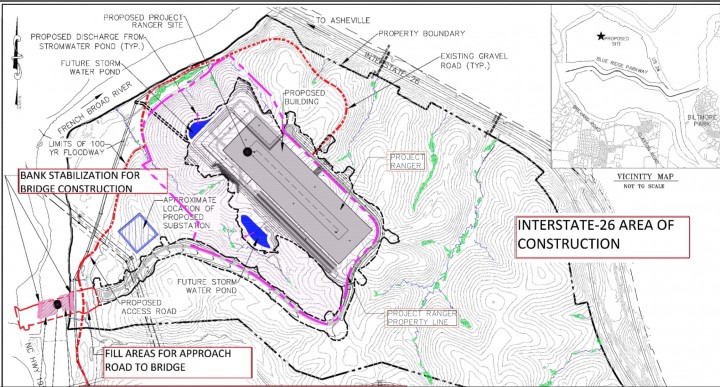
Why Should We Worry about a Jet Engine Parts Factory? Isn’t it Worth it? For the Jobs?
Sometimes it is hard to see what consequences a single airplane parts manufacturing plant can have on the world, especially thousands of miles away. However, when the plant is owned by Pratt and Whitney and is a subsidiary of Raytheon Technologies the consequences can be deadly.
Pratt and Whitney was acquired in the first half of 2020 by Raytheon Technologies. This company holds many defense contracts with the Pentagon and often produces weapons that are sent overseas to places like Saudi Arabia, Israel and Morocco. The plant in Asheville would be producing engines for the F-35 Joint Strike Fighter Jet, many of which will find their way to other countries in deals that have been brokered by the Trump administration-deals which President Trump claimed are being made in order to stimulate the economy and create jobs. Raytheon Technologies has deep ties to the defense community. They spend millions lobbying in congress for beneficial policies and have ties to high-ranking Defense Department officials including previous Secretary of Defense Mark Esper and Biden’s nomination for Secretary of Defense Lloyd Austin III.
Raytheon is an integral part ofthe military industrial complex. Over the years our war economy has grown exponentially. Even the recently passed Covid-19 relief package contained money earmarked for supplying foreign conflicts. As the Middle East and North Africa are ravaged by wars and conflicts, the US makes money and deals that have nothing to do with spreading peace and democracy. Our country supplied 48% of weapons deliveries to the Middle East and Northern Africa between 2015 and 2019. The US is Saudi Arabia’s prime arms supplier which means that weapons created by United States companies are being used in Yemen, the worst humanitarian crises of our time, according to the United Nations. To make matters worse, despite claims of creating half a million jobs with the sale of military equipment the actual number is roughly a tenth of that. This means that for all the bloodshed we are perpetuating the American People are not even getting the promised economic return on our investment.
The US military industrial complex is also one of the largest contributors to climate change, and Raytheon itself is known for having a poor environmental record. It has a reputation for buying companies with a history of polluting and pretending to clean them up, while simply allowing the pollution to continue. From coast to coast, factories affiliated with Raytheon have left polluted areas that will take decades to restore. By 2008 Raytheon had already been the subject of over 90 lawsuits for tainted soil and water. The worst part? The corporation doesn’t seem to care at all. It has been fined repeatedly and, in multiple instances, the EPA has had to force it to comply with cleaning up the polluted soil and water. In Arizona a facility that Raytheon was supposed to be in the process of cleaning up sent cancer-causing chemicals into ground water impacting over 50,000 people. In 1995 they bought E-Systems in St. Petersburg Florida. This factory was a known polluter, and Raytheon allowed the problem to worsen until 1999.
The Pratt and Whitney plant is being touted as a job creator that will help the economy and be built with environmental concerns in mind. The question is: at what cost? Are 600-800 jobs worth it? With the current economy favoring the military industrial complex over civilian air travel, our community will be contributing to war world wide. War profiteers have been an integral part of our nation’s economy for years, and Raytheon is among the worst. Do we want jets built with engines from Asheville to drop bombs on innocent people?
We will also be contributing to potential environmental disaster. If this plant is sited beside our beloved French Broad River, we will be trusting a company that has consistently ignored EPA regulations with one of our most important resources.
The damage this plant has the potential to inflict both on our community and globally is concerning, and the question you must ask yourself is, is it worth it?
Sources for article:
Raytheon laying off 20,000 amid commercial aviation slide – Joe Gould, Defense News, 10/27/20
Raytheon sees deep drop in profits, plans more cost-cutting – Zachary Vasile, Journal-Inquirer, 10/27/20
Biden picks Raytheon board member to lead the US was machine – Caitlin Johnstone, 12/8/20
Raytheon sheds 8,000 aerospace jobs amid collapse in air travel – Ryan Beene, Bloomberg, 7/28/20
All about the F-35: Raytheon Technologies makes much of what goes in and on the futuristic fighter jet – Raytheon Technologies, 7/15/20
The U.S. of A(rms) – William Hartung, Common Dreams, 10/13/20
Raytheon spotty on clean up programs – Andrew Dunn., Tampa Bay Times, 8/20/08
Economic Development over Transparency and People
How does an enormous industrial project, like the 1.2 million square foot aerospace manufacturing Pratt & Whitney plant come about without the public’s knowledge?
Thanks to Matt Matteson in his Hendersonville Lightning article, Bridge far enough helped seal deal for jet engine plant, we learned about the wheeling and dealing that goes on out of the sight of citizens, to court and negotiate with a multi-national defense contractor like Pratt & Whitney. In spring 2019, a team of NC Economic Development Partnership (EDP) officials attended the International Air Show in Paris, a trade show where tens of thousands of aircraft vendors and potential buyers demonstrate what they have to offer. In a “chat” NC reps began to woo Pratt & Whitney to our state, letting P&W know that North Carolina was interested.
Biltmore Farms, LLC had previous informed the NC Dept. of Commerce and the Economic Development Partnership that it had 445 acres ready for development. In a call for RFPs from the economic development offices in the state, Buncombe County responded.
Soon after the Paris Air Show, the NC EDP invited Pratt & Whitney officials to North Carolina, twice. During the first visit in the summer 2019, the EDP shared what the state had to offer, inc., potential sites and employee training opportunities. In August 2019, during the 2nd visit to the state, P&W officials toured potential sites by helicopter. Asheville, one of 10 potential sites, was on the tour. At this point the project was called Project Ranger. Involved NC officials, including County Commissioners were required to operate under a non-disclosure agreement.
After the field of site options was narrowed to two, meetings between Pratt & Whitney, Biltmore Farms and other Buncombe Co. officials continued. “Cost of living and quality of life were primary concerns,” Ben Teague, VP of Biltmore Farms said. “As the process developed, we found that Biltmore Farms’ values meshed well with those of the company and fit with our long-term vision for what the property could do for the community.” (Hendersonville Lightening).
Key to the landing the deal with Pratt & Whitney was the building of a bridge over the French Broad River, since the only access to the 445 acres is a dirty road along the French Broad that can only be reached through Biltmore Park. State Rep. Chuck Edwards sealed the deal when he landed a $12M grant from the Golden Leaf Foundation for the building of the bridge to fund the 5-lane $15 million bridge. Biltmore Farms would fill the gap.
With bridge funding in place and assurances that AB Tech could provide training for potential employees, the Buncombe Co. site became the chosen site for the Pratt & Whitney plant. An economic development jewel, according to local economic development officials.
But, rapid approval for the building of the bridge was needed, Pratt & Whitney claimed, as it wanted to make the announcement about the new plant in April 2020. Perhaps we should thank COVID for the slow down of the process, although application to the Army Corps of Engineers was initiated in Oct. 2019. See the timeline of events below.
Approval Timeline for Project Ranger: Pratt Whitney Manufacturing Plant
Oct. 9, 2019
Engineering firm hired by Biltmore Farms began contact with US Fish and Wildlife Biologists
Nov. 2019
Pre-construction Notification rec’d by Army Corp of Engineers for factory access bridge building; site was visited in by NC Wildlife Resource Commission. Interestingly, the Pre-construction Notification states that Biltmore Farms is proposing a manufacturing plant on 445 acres of their land at the site.
Water Quality Permit Application submitted to Division of Water Resources; bridge building plan revised in March 2020
Jan. 2020
Application for permit from Army Corp of Engineers submitted.
Biltmore Farms knew who the company was who would build a manufacturing facility at their site. (as stated in a letter from BF to the Wildlife on 1-6-20). The letter states that the company and construction of the site was time-sensitive timeline. BF was hoping to begin clearing the site in May 2020.
01/9/20 Letter from Biltmore Farms outlining their plans for excavation of the site. https://edocs.deq.nc.gov/WaterResources/DocView.aspx?id=1070914&dbid=0&repo=WaterResources
ACoE sent Biltmore Farms a letter insisting that consultation and coordination with the US Fish and Wildlife Services, National Historic Preservation and NC State Historic Preservation was necessary before any work could be done at the site. Biltmore Farms had intended to do excavation work by a May 15th deadline. Source: https://edocs.deq.nc.gov/WaterResources/DocView.aspx?id=1070912&dbid=0&repo=WaterResources
Feb. 2020
Dept. of Water Resources stated in a letter to the Army Corp of Engineers that it would hold a public hearing on the application Biltmore submitted..
DWR requests an 8 month review extension for the site from Army Corp of Engs.
March 2020
Water Quality Public Comment hearing cancelled. Open written comment period
Documented responses regarding the environmental impact of building the bridge.
3/6. Letter from Clear Water, the BF-hired environmental firm, to the ACoE states that Duke is building a substation on the land. It will be close to the bridge. Source: https://edocs.deq.nc.gov/WaterResources/DocView.aspx?id=1111707&dbid=0&repo=WaterResources
April 20, 2020
Deadline for written public comments about BF’s application for Water Quality certificate. 18 comments received; most not about the issues covered by the water quality certificate.
June 2020
In fiscal year 2019-2020 (July-June), the Asheville Area Chamber of Commerce Community Betterment Foundation was award $12 million from the Golden L.E.A.F foundation for the building of the access bridge.
July 9, 2020
Biltmore Farms receives authorization from Army Corp of Engineers for wetland fill for the construction of the 5-lane bridge over the French Broad to access the Pratt Whitney factory site. The July authorization outlined recommendations for maintaining wildlife habitat (Appalachian elktoe, gray bat, bog turtle among others), controlling stormwater, maintaining the riparian forest.
Source: https://edocs.deq.nc.gov/WaterResources/Welcome.aspx?dbid=0&repo=WaterResources&cr=1 File#: 20191577
Oct. 22, 2020
Governor Cooper and Asheville Chamber of Commerce announces the Pratt Whitney project.
October 31, 2020
John Boyle Article in Citizen Times https://www.citizen-times.com/story/news/local/2020/10/31/pratt-whitneys-650-m-asheville-plant-expected-spawn-more-investment/6075798002/
Nov. 17, 2020
Buncombe County Commissioners approve $27M in tax incentives for the project.
Jan. 14, 2021
Pratt & Whitney receives approval from the Buncombe Co. Board of Adjustment for a Conditional Use Permit for the building of the manufacturing plant
